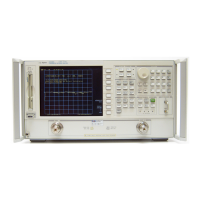Service Guide 10-21
8719ET/20ET/22ET Service Key Menus and Error Messages
8719ES/20ES/22ES Analog Bus on OFF
RF Network Analyzers
Notes
• The display and marker units (U) correspond to volts.
• About 0.750 MHz is a typical counter reading with no ac signal present.
• Anything occurring during bandswitches is not visible.
• Fast-moving waveforms may be sensitive to sweep time.
• The analog bus input impedance is about 50K ohms.
• Waveforms up to approximately 200 Hz can be reproduced.
Analog In Menu
Select this menu to monitor voltage and frequency nodes, using the analog bus and
internal counter.
To switch on the analog bus and access the Analog In menu, press:
The key toggles between low and high resolution.
allows you to monitor the analog bus nodes (except nodes
1, 2, 3, 4, 9, 10, 12) with external equipment (oscilloscope,
voltmeter, etc.). To do this, connect the equipment to the
AUX INPUT BNC connector on the rear panel and press
until selected.
CAUTION To prevent damage to the analyzer, first connect the equipment to the rear
panel AUX INPUT, and before turning the function ON.
switches the internal counter off and removes the counter
from the display. The counter can be switched on with one
of the next three keys. (Using the counter slows the
sweep.) The counter bandwidth is 16 MHz unless
otherwise noted for a specific node.
NOTE OUTPCNTR is the GPIB command to output the counter's frequency data.
switches the counter to monitor the analog bus.
Table 10-2 Descriptions of Jumper Positions
Resolution Maximum Signal Minimum Signal
LOW +0.5 V −0.5 V
HIGH +10 V −10 V
System
Meas

